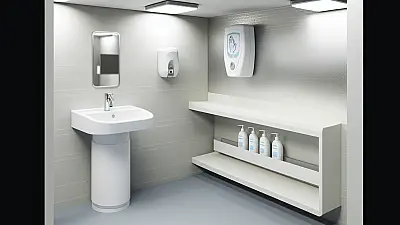NEW BRAUNFELS, TX - A recent inspection at Legend Oaks Healthcare and Rehabilitation revealed the facility failed to ensure mandatory annual infection control training for at least one employee, potentially placing residents at risk due to inadequately trained staff.

Critical Training Gap Discovered During Inspection
The March 28, 2025 inspection found that Cook D, hired in December 2023, had not received required annual infection control training since January 26, 2024. This represents a gap of over 14 months without the mandatory training that ensures staff remain current on infection prevention protocols.
The violation is particularly concerning given the critical role that infection control plays in nursing home settings, where residents often have compromised immune systems and are at heightened risk for healthcare-associated infections. Federal regulations require all nursing home employees to receive annual training on infection prevention and control standards to maintain a safe environment for vulnerable residents.
System Failure in Training Oversight
The inspection revealed significant breakdowns in the facility's training oversight system. The HR Manager relied on weekly reports from the Relias training platform to identify employees requiring annual training within 30 days. However, Cook D's name never appeared on these reports, indicating a systematic failure in the tracking mechanism.
During interviews, the HR Manager acknowledged that "by not training staff annually it increased the likelihood that a staff member could do something wrong and put the residents in harm's way." This statement underscores the facility's own recognition of the risks posed by inadequate training protocols.
The Administrator confirmed that both HR and administrative staff were responsible for ensuring annual training completion. Department heads were tasked with following up on training requirements after receiving reports identifying staff with upcoming training deadlines.
Medical Significance of Infection Control Training
Infection control training is not merely a bureaucratic requirement but a critical component of resident safety. In nursing home environments, proper infection prevention protocols can mean the difference between containing an outbreak and experiencing widespread transmission among vulnerable residents.
Annual training ensures staff remain current on evolving best practices, proper use of personal protective equipment, hand hygiene protocols, and isolation procedures. Without regular updates, staff may inadvertently use outdated techniques or fail to recognize early signs of infectious diseases.
Healthcare-associated infections are among the leading causes of morbidity and mortality in long-term care facilities. Studies indicate that nursing home residents are at significantly higher risk for infections due to age-related immune system changes, chronic medical conditions, and frequent antibiotic use that can lead to resistant organisms.
Regulatory Requirements and Industry Standards
Federal regulations mandate that nursing homes implement comprehensive infection prevention and control programs that include mandatory annual training for all staff members. These requirements stem from decades of research demonstrating the effectiveness of systematic infection control measures in reducing preventable infections.
The facility's own policy, dating from April 2004, explicitly lists "Prevention and control of infections" as one of the mandatory in-service training classes that each employee must attend. This policy also requires training on "Problems and needs of the aged chronically ill, acutely ill, and disabled patients," emphasizing the facility's obligation to ensure staff understand the unique vulnerabilities of their resident population.
Industry best practices recommend not only annual training but also ongoing education during infection outbreaks, introduction of new protocols, or when gaps in compliance are identified. Many facilities implement quarterly or monthly infection control updates to supplement annual requirements.
Technology and Human Oversight Challenges
The incident highlights common challenges in healthcare training management, where facilities often rely heavily on automated systems to track compliance. While technology platforms like Relias can streamline training administration, they require proper configuration and regular validation to ensure accuracy.
The fact that Cook D's training requirements went undetected for over a year suggests potential issues with either the software setup, data entry, or the validation processes used to verify system accuracy. This case demonstrates why many facilities implement backup tracking methods and regular audits of training records.
Administrator Acknowledges Risk to Resident Care
The facility's Administrator emphasized the connection between training compliance and quality care, stating that "if staff were not trained it put resident at risk for receiving poor care." This acknowledgment reinforces the direct link between administrative oversight and resident outcomes.
The Administrator noted that training ensures staff remain "up to date on policies and procedures to ensure quality care was being provided." This statement reflects understanding of the regulatory intent behind mandatory training requirements and their role in maintaining care standards.
Additional Issues Identified
The inspection documentation indicates this was part of a broader review of infection prevention and control programs. While the specific violation focused on training deficiencies, such reviews typically examine multiple aspects of infection control implementation, including policy adherence, environmental controls, and surveillance practices.
The facility must now develop and implement a plan of correction to address the identified training gap and prevent similar occurrences. This typically includes immediate training for affected staff, system improvements to prevent future oversights, and enhanced monitoring procedures.
The violation carries minimal harm classification, indicating inspectors determined the training gap posed potential rather than actual harm to residents. However, the "few residents affected" designation suggests the scope of potential impact was considered significant enough to warrant regulatory action.
Full Inspection Report
The details above represent a summary of key findings. View the complete inspection report for Legend Oaks Healthcare and Rehabilitation - New Br from 2025-03-28 including all violations, facility responses, and corrective action plans.
💬 Join the Discussion
Comments are moderated. Please keep discussions respectful and relevant to nursing home care quality.